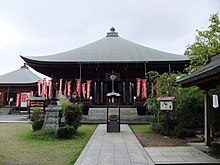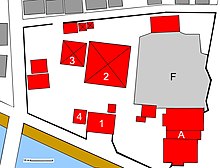Kōmyō-ji (Hiratsuka)
The Kōmyō-ji ( Japanese 光明 寺 ), with the mountain name Kaname-san ( 金 目 山 ), also called Kaname Kannon-dō ( 金 目 観 音 堂 ), is a temple of the Tendai direction of Buddhism in Hiratsuka ( Kanagawa Prefecture ), Japan. In the traditional count it is the 7th of the 33 temples in the Kantō region .
history
According to tradition, fishermen found a small Kannon statue on the beach of Koiso ( 小 磯 ) in Taihō 2 (702) , which they then venerated. During the Tempyō era (729-749), priest Gyōki made a Kannon, inside which he included the found. It was said to have had a supernatural effect.
In the early Kamakura period the Temple of was Minamoto no Yorimasa highly valued in the time of the North and Südhofs or Muromachi period supported Ashikaga Takauji , the Kanto Kubo and other temple. But then the Eikyō turmoil ( 永享 の 乱Eikyō no ran ) broke out in 1438 , and the Ōnin war also brought much calamity, so that the temple was completely devastated at the end of the 16th century.
During the Meiō era (1492-1501) Ōta Dōkan and others achieved the reconstruction.
The attachment
You enter the temple complex, located directly on the Kaname River (blue on the plan), from the south through the temple gate ( 山門 Sammon ; 1 in the plan), which is here as the Nio gate ( 仁王 門 Niō-mon ), i.e. as a gate the two temple guards ( Niō ) to the right and left of the passage. Immediately to the left of the temple gate is the bell tower ( 鐘楼 Shōrō ; 4). The main hall ( 本 堂 Hondō ; 2) stands in front : the current building with a square floor plan dates from Meiō 7 (1498) and was probably built by the monk Kuyōji ( 供養 時 ). The Kanki-dō ( 歓 喜 堂 ; 3) stands next to the main hall, offset to the rear .
The abbot and monk's quarters (A) and the cemetery (F) are on the eastern side of the temple grounds.
Treasures of the temple
In the main hall, the main cult figure , a standing Kannon ( 寄 木造 聖 観 世 音 菩薩 立 像 Yosegizukuri Shō-Kanseon bosatsu ritsuzō ) is housed in a cabinet ( 厨子 Zushi ; important cultural asset of Japan ) in the Zen style. In front of the cabinet there is a Kannon, called Maedachi Kannon ( 前 立 観 音 ), which, like the main hall, dates from 1498. There is also a temple bell ( 梵 鐘 Bonshō ) in the main hall . According to the inscription, it dates from 1352 and was donated by the high priest Kūnin ( 空 忍 ). The temple also has valuable old documents, including writings by Tazoe Hidenori ( 田 副 秀 則 ) owned by the lord of the castle at Hamamatsu Castle , Honjō Munetoshi ( 本 庄 宗 俊 ), donated in 1710.
Remarks
literature
- Kanagawa-ken kotogakko Kyoka kenkyukai shakaika bukai rekishi bunkakai (Ed.): Komyo-ji (Kaname Kannon-do) . In: Kanagawa-ken no rekishi sampo (ge). Yamakawa Shuppan, 2005. ISBN 978-4-634-24814-4 . Pp. 179,180.
Coordinates: 35 ° 21 ′ 31.5 ″ N , 139 ° 17 ′ 19.6 ″ E

